Research on Market Risk Assessment of Dairy Farms: Taking 75 Dairy Farms in Heilongjiang Province as Examples
Li Yan-ling, and Li Cui-xia
College of Economics and Management, Northeast Agricultural University, Harbin 150030, China
Introduction
With the promotion of national policies, the scale of dairy farming has gradually increased in recent years, and large numbers of decentralized farmers have gradually withdrawn from the market, and largescale dairy farms have become the main forms of organization. The risks faced by dairy farms mainly include market risk, disease risk, natural risk and technical risk, among which market risk can be said to be the most complex and variable types of risk. In the first half of year 2016, the loss of dairy cows in China exceeded 50%. It is challenging that changes in the global economic climate have transformed the market environment into a turbulent and continuously divisive one, making it difficult for dairy farms to anticipate the market demand. In addition, the industry consolidation, globalization and the attention to lean production have brought about the enormous pressures on dairy industry, and it is difficult to respond to the large fluctuations in demand through an effective supply response because of this fact. These factors have forced dairy farms to shift their attention from simple demand signals, such as trend and seasonality,to more dynamic demand signals, such as price and policy factors, in order to face complex market changes and risks.
Some scholars regarded the market risk as a possibility that the actual income of the production and business unit in the actual operation process may be deviated from the expected revenues, due to changes in the external market economic environment or accidental factors (Mu and Chen, 1994; Nie, 2006).The effect of market risk on a unit is uncertain and may make it profitable, but may also cause it to lose money. Different scholars have different classifications for the study of market risk indicators. The dairy market risk index system mainly includes the milk market price index, milk sales and the diversity of milk sales channels. The risk assessment is conducted using single risk assessment and multifactor fuzzy evaluation (Jia, 2007). Dairy farmers' market risk can be decomposed into cost risk and transaction risk.Under different market conditions, dairy farmers have different risk preferences and their behavioral choices also exist differences (Daoet al., 2013). Layer farms face market risks in terms of production, sale and external shocks. Among these, the major risks that are difficult to control come from the production materials, the floating prices of finished products and disease emergencies (Zhou and Qin, 2016).When the 317 farmers in Guangdong Province faced these market risks, farmers mainly depended on themselves to avoid risks. The government supports them very few, and the market risks caused by the policy factors are significant (Chen and Dong,2014). Various circulation links in the agricultural industry chain will cause market risks for various entities in the industry chain, due to the variability of the market, including price risk, information risk and competition risk (Xiao, 2012). The main risk affecting farmers' operating income is market risk, which is mainly reflected in price fluctuations.The price plays a major role in farmers' decisionmaking in the next year, but the ability of farmers to evade and prevent market risks is limited (Xuet al.,2010), so in terms of the price risk of agricultural products, the relevant government departments should formulate a good subsidy mechanism, agricultural product price insurance and funds, and do a good job of monitoring and early warning (Heet al., 2015).Incomplete information and information asymmetry have significantly reduced the operational efficiency of the market and led to market risks (Peng and Liao, 2007). The market risks of restricting the pig industry in Jiangxi Province mainly include lacking of professional services to the industry, rising costs,operational production and marketing management systems, and so on. It is necessary to strengthen the policy support and risk control of the industry (Zhenget al., 2016). In the agricultural industrialization,the increase in the risk of farmers is mainly due to lacking of adequate agricultural information and equal competitive position. Therefore, in order to speed up the process of industrialization, a balance mechanism should be established between the market entity and farmers, and the agricultural informationization should be increased. Reduce farmers' market risk through effective agriculture support policies (Luo and Pan,2006). Based on the classification and perspectives of scholars on market risk in recent years, combined with the actual situation, the market risk studied in this paper was the unpredictability of earnings due to the unpredictability of price fluctuations during the purchase and sale of dairy farms on the market,and also referred to the unpredictability of profits caused by changes in price of raw milk and production factors. In the process of purchasing raw materials,the following conditions would affect the dairy farms:first, due to lacking of information and logistics obstruction, dairy farms could not find a suitable raw material supplier in a timely manner; second, the price of production factors went up; third, suppliers'opportunistic behavior, such as the production factors,was not ideal. During the sale of raw milk, the following situations would affect the dairy farms: first,dairy farms could not timely find the suitable raw milk buyer; second, the price of raw milk fell; third, raw milk purchasers' opportunistic behavior. Therefore,after analysis and synthesis, market risk of dairy farms was mainly presented by five aspects: price risk contract risk, production risk, pairing risk, and policy risk. Although policy risk was easily overlooked,national policy had its non-negligible impact.
Construction of Market Risk Assessment Index System for Dairy Farms
According to the five elements of market risk assessment of dairy farms selected in this paper, the criteria layer was established. There were five primary indicators of the criteria layer, which were the pairing risk between dairy farms and suppliers of production factor or dairy enterprises, the price risk of raw milk,the production risk of feed and raw milk, the contract risk between dairy farms and suppliers of production factor and dairy enterprises and related policy risk.
Pairing risk (u1). In the process of production and operation, dairy farms needed to look for suppliers of production factors and the acquisition of raw milk enterprises, and formed a cooperative relationship with them. The suppliers of production factors included feed suppliers, calf suppliers, equipment suppliers, veterinary drug suppliers and so on. Pairing risk included the fixed degree of farming inputs (u11),the fixed degree of raw milk sale (u12), and the fixed degree of market monopoly (u13). Dairy farms were not isolated parts of industrial chain. The connection of the upstream and downstream enterprises could not be identified to be stable. Dairy enterprises which could be chosen for sale were single were key factors to market risk. If dairy farms matched and contacted with other enterprises steadily, market risk of dairy farms would be relatively low.
Price risk (u2). The profit of raw milk was determined by the price and cost. In recent years, the fluctuation of cow raising costs wasn't big, it was basically in a stable state, so price risk was the key to market risk and could represent market risk basically,so the change in price was very important to the benefits of dairy farms. When low price happened, the benefits would be lower than expected earnings, and market risk would follow.
Production risk (u3). Production risk included the proportion of the roughage self-produced (u31), the proportion of the concentrate self-produced (u32) and the production of raw milk (u33). If farmers produced feed for their own cow farms, they would reduce the feeding cost and the opportunity cost, improve profitability and reduce market risk. National policy called for the combination of cultivating and feeding and ecological cycle, so the proportion of selfproduced feed could reflect the market risk to a certain extent. In addition, the production of raw milk in dairy farms was also an important factor in sales, and market risk would be relatively low if the volume of purchase was greater or equal to the production of raw milk.
Contract risk (u4). Contract risk included the ratios of fulfilling the obligation on a contract for production suppliers (u41) and dairy enterprise (u42). Contract risk was the risk of loss to the signatory of the other party,due to the failure of one party to execute the contract.Under the condition of market economy, contract risk of dairy farms mainly manifested as the arrears of arrears of milk, the buyers refusing or limiting to accept the raw milk, and the loss to the dairy farms causing by production factor suppliers having not provided production materials according to the contract.
Policy risk (u5). Policy risk included farming allowance amount (u51), farming allowance paid time (u52) and related insurance products (u53). The government's support policy was very important to market risk of dairy farms. If the government's support was effective, which could guarantee the income of dairy farms, so that the actual income would not deviate from the expected profit a lot and it would reduce market risk. In addition, the dairy farms participated in the dairy insurance or not also affected the actual income. General practice in China was the policy insurance, which would pay for the losses of specific event happened under the cow death. This kind of insurance had the premium subsidy from the government,and the dairy farm only needed to pay a small premium.Participation in the insurance could reduce the loss of property during the death of the cow, which was very important for the benefit of dairy farms.
According to the above analyses, evaluation index system consisted of target layer, the 1st level index layer (standard layer) and the 2nd level index layer(factor layer). Among that, target layer was market risk of dairy farms, the 1st level index layer included five first grade indexes, and the 2nd level index layer included 12 second grade indexes. The specific structure of evaluation system is shown in Table 1.
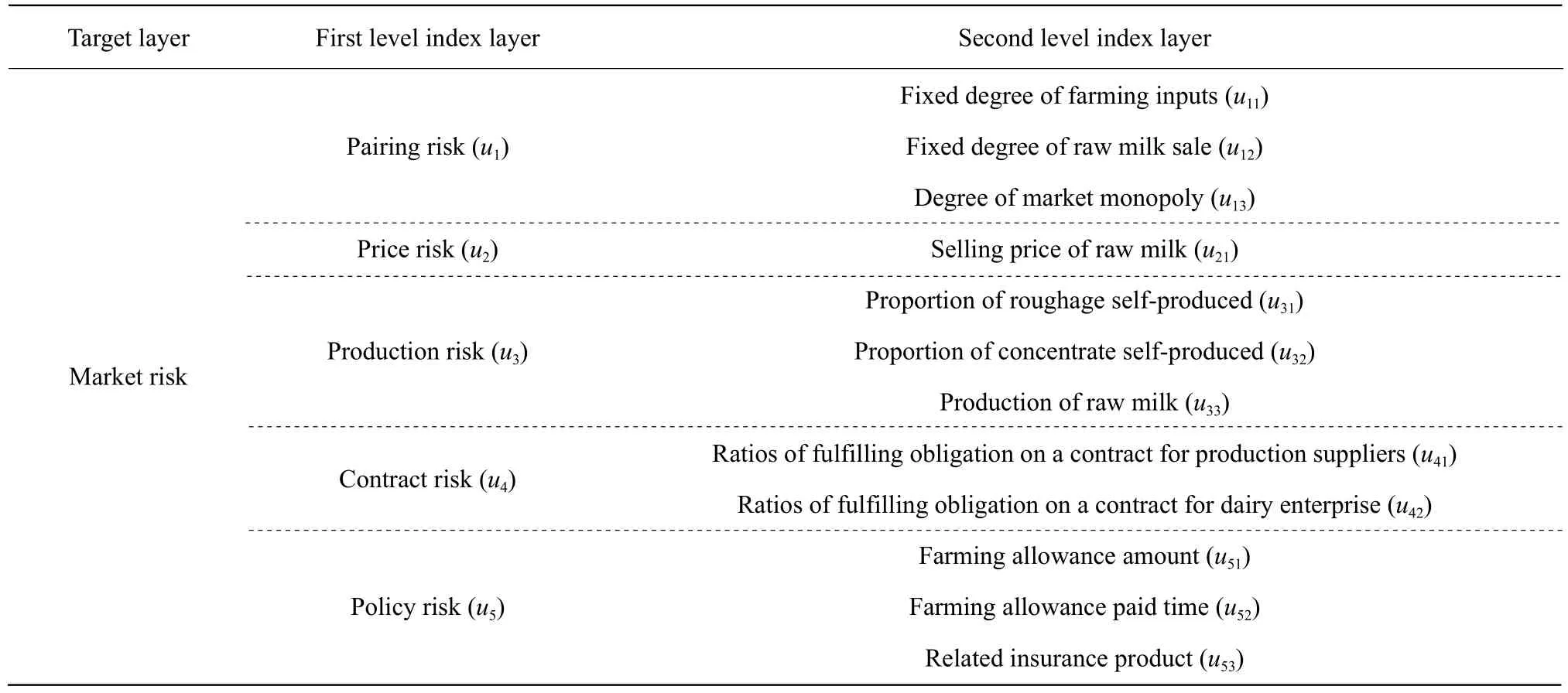
Table 1 Market risk assessment index system for dairy farm
Market Risk Assessment Method and Empirical Analysis of Dairy Farms
Selection of market risk assessment methods for dairy farms
Market risk of dairy farms was determined by many factors, which included fixed degree of farming input, fixed degree of raw milk sale, degree of market monopoly, selling price of raw milk, self-production ratio of fodder, production of raw milk, ratios of fulfilling the obligation on a contract for production suppliers and milk enterprise, farming allowance amount, farming allowance paid time and whether participating in related insurance. So it was necessary to assess all the factors and make a comprehensive assessment on the basis of the individual assessment of each factor.
Fuzzy comprehensive evaluation was a general evaluation of target objects using fuzzy mathematical method in the case of many factors. Therefore, based on the characteristics of market risk assessment of dairy farm, the fuzzy comprehensive evaluation method was adopted in this paper. The main steps of this method were as the followings. (1) Assessment factor set and evaluation set of dairy farm market risk were established. (2) Factor evaluation matrix was identified through fuzzy evaluation of single factors.(3) Factor weight was determined. (4) All the levels of factors were evaluated synthetically and finally the results of market risk comprehensive evaluation were calculated.
Empirical analysis on market risk assessment of dairy farms
According to the research data and material of dairy farms in Heilongjiang Province, a assessment panel of 15 people which was consisted of managers of dairy farms was set up, the members of village committee in breeding area, the employees who managed the source of milk in dairy enterprises and the teachers and students of industrial economics. Based on the theoretical knowledge and reality, the teachers and students in assessment panel divided market risk of dairy farms into four levels: low risk, medium risk, the higher risk and the highest risk, and set the evaluation standard of pairing risk, price risk, production risk,contract risk and policy risk to evaluate the degree of market risk of dairy farms.
Evaluation standard of pairing risk
The evaluation standard of fixed degree of farming inputs (u11): the suppliers of feed, cattle, equipment and veterinary drug were all fixed with low risk. Two or three suppliers were fixed and other suppliers were not fixed with medium risk. Only one supplier was fixed with higher risk. All inputs were not fixed with the highest risk. The evaluation standard of fixed degree of raw milk sale (u12): for low risk, the dairy farm signed a written agreement with an enterprise or a dairy station and considered to renew. When the agreement was terminated. For medium risk, the sales target was individual. For higher risk, the dairy farm didn't consider to renew. Oral agreement was the highest risk. The evaluation standard of degree of market monopoly (u13): low risk was three or more sales targets for choice. Medium risk was two sales targets for choice. Higher risk was one sale target for choice. For the highest risk, the dairy farm had only one sale target and had much unsold milk.
Evaluation standard of price risk
The evaluation standard of selling price of raw milk(u21): for low risk, the price was higher than the operating cost of dairy cows. For medium risk, the price was equal to the operating cost. For higher risk,the price was less than 5% of the operating cost. For the highest risk, the difference between price and cost was more than 5% of the cost.
Evaluation standard of production risk
The evaluation standard of proportion of roughage self-produced (u31): for low risk, the proportion was more than 60%. For medium risk, the proportion was between 40% and 60%. For higher risk, the proportion was between 20% and 40%. For the highest risk, the proportion was less than 20%. The evaluation standard of proportion of concentrate selfproduced (u32): for low risk, the proportion was more than 60%. For medium risk, the proportion was between 40% and 60%. For higher risk, the proportion was between 20% and 40%. For the highest risk,the proportion was less than 20%. The evaluation standard of production of raw milk (u33): for low risk,acquisition volume of dairy enterprises was greater than production of farms or equal to production of farms. For medium risk, production of farms was instable or falling due to mismanagement. For higher risk, acquisition volume of dairy enterprises was less than production of farms. For the highest risk,acquisition volume of dairy enterprises was far less than production of farms so that dairy farms poured milk and killed cows.
Evaluation standard of contract risk
The evaluation standard of ratios of fulfilling obligation on a contract for production suppliers (u41): when the loss of the dairy farm was caused by unsatisfactory production materials, the loss less than 500 Yuan was low risk. The loss between 500 and 2 000 Yuan was medium risk. The loss between 2 000 and 5 000 Yuan was higher risk and the loss more than 5 000 Yuan was the highest risk. The evaluation standard of ratios of fulfilling obligation on a contract for dairy enterprises(u42): no rejected, limited purchase of raw milk and no arrears of milk income belonged to low risk. Medium risk was rejected and limited purchase of raw milk.For higher risk, the income of milk was defaulted. For the highest risk, the process of collecting milk was not transparent and the collector accepted bribes.
Evaluation standard of policy risk
The evaluation standard of farming allowance amount(u51): raising farming income obviously was regarded as low risk. Making profits stable was regarded as medium risk. Narrowly ensuring benefits not to be negative was regarded as higher risk, and guaranteeing income barely was regarded as the highest risk. The evaluation standard of farming allowance paid time(u52): releasing timely was regarded as low risk.Releasing a little bit later was regarded as medium risk. Long overdue subsidy leading to low capital turnover rate was regarded as higher risk. Meeting the standards, but no releasing was regarded as the highest risk. The evaluation standard of relevant insurance products (u53): maintaining stable income by participating in the revenue assurance insurance or establishing risk fund locally was regarded as low risk. The significant loss reduction by attending the cow policy insurance was regarded as medium risk.The less loss reduction by attending the cow policy insurance was regarded as higher risk, and no attending any insurance was regarded as the highest risk.
Based on the above, factor set for assessing the market risk of dairy farms were determined as the followings:
U={pairing risk (u1), price risk (u2), production risk(u3), contract risk (u4), policy risk (u5)}
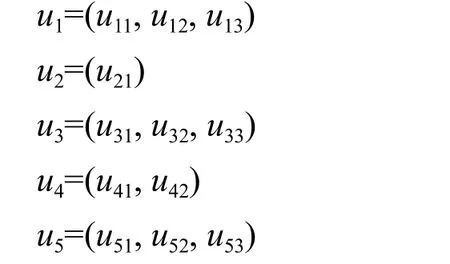
The evaluation set:V={low level risk (v1), medium risk (v2), the higher risk (v3) and the highest risk (v4)}.
The evaluation of degree of fixation of breeding inputs (u11) shown in the survey data, for example, was completed by face to face or telephone research on the dairy farms of key counties in Harbin, Daqing,Qiqihaer, Suihua cities and some state-owned farms of Heilongjiang Province. Eighty-one questionnaires were completed and 75 questionnaires were valid. 38%of the dairy farms were fixed in feed, calf, equipment and veterinary drugs providers. 50% of the dairy farms were fixed in two or three providers. 8% of the dairy farms were only fixed in one means of production providers. 4% of the dairy farms were fixed in no inputs. Therefore, the evaluation matrix of degree of fixation of breeding inputs was:

The same principle was respectively applied to establish assessment matrix of pairing risk, price risk,production risk, contract risk and policy risk:
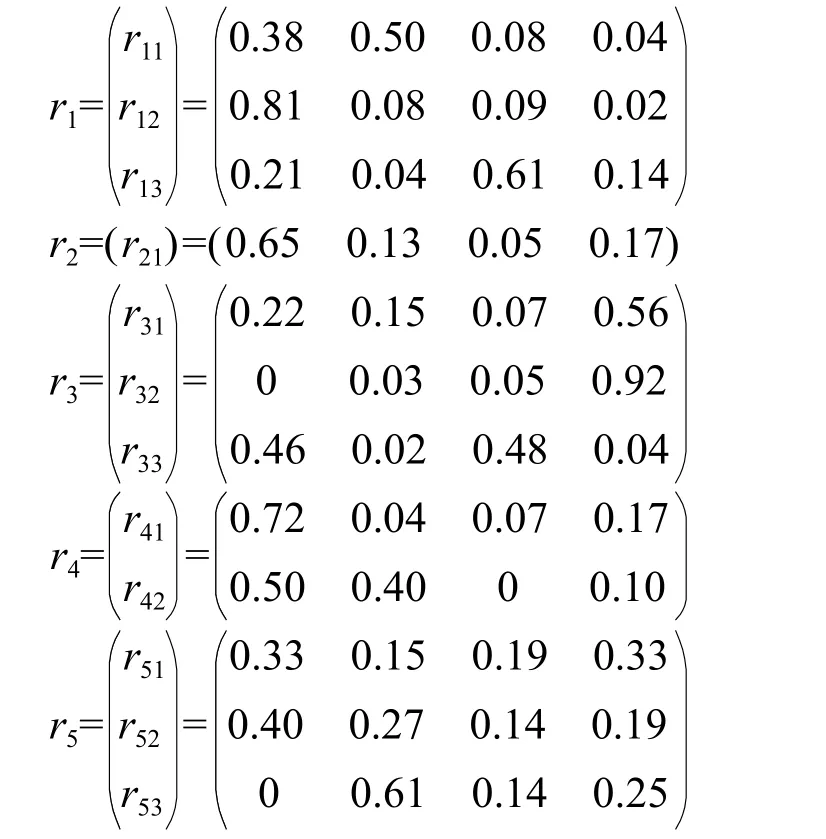
Assessment team members evaluated the relative importance of the first-class and the second-class targets respectively, combining with the actual situation of dairy farms, and determined the arithmetic average of the first-class and the second-class targets,in order to ensure the power of each factor as the followings:
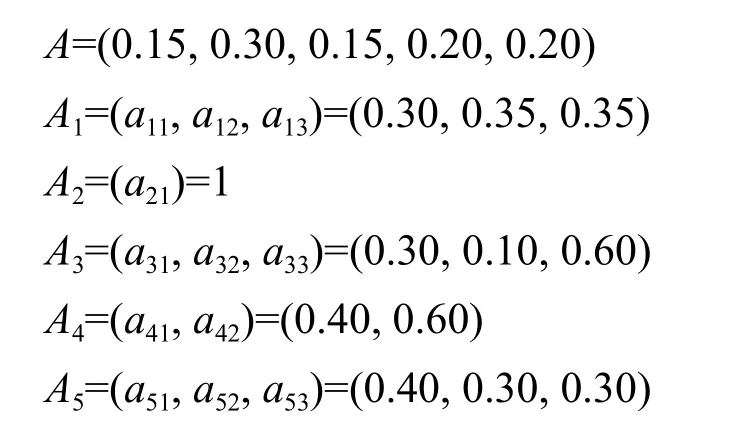
Multiple indices should be considered, when market risk of dairy farms was evaluated. In consideration of the situation of determining the weight of each target, the weighted average operator M(∧,⊕) was used in this paper. The operator had a higher degree of integrated effect. The calculation formula was as the followings:

A further comprehensive assessment was applied to the five factors named pairing risk, price risk,production risk, contract risk and policy risk. The factor evaluation matrix was composed ofB1,B2,B3,B4andB5:
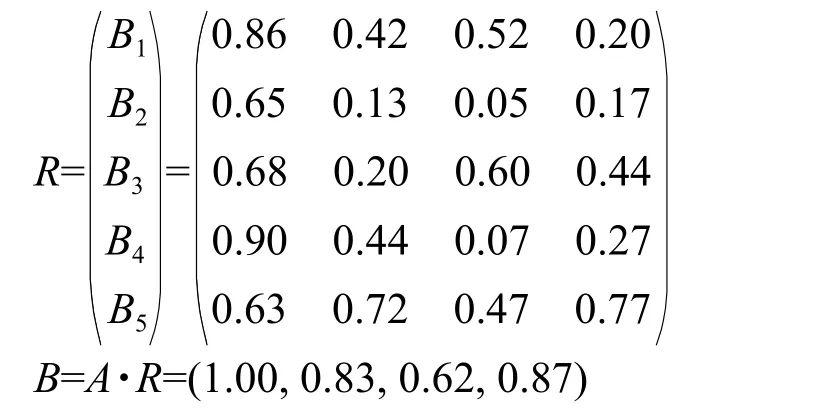
The normalization ofBwasB=(0.30, 0.25, 0.19 and 0.26)
According to the principle of maximum subordination, the maximum value ofB1,B2,B3,B4andBwas all at the low level risk, only the maximum value ofB5was at the highest risk. It showed that pairing risk,price risk, production risk and contract risk were all at low risk, and market risk which the five risk factors combined to represent was also at low risk, but policy risk was at the highest risk. Therefore, the market risk of dairy farms in Heilongjiang Province was at low risk level; however, high policy risk which dairy farms faced extremely caused the biggest impact.
In terms of the evaluation results, fixed degree of farming inputs was at the medium risk level, it showed that the farming inputs of the sample farms were not very fixed, which increased the time cost and opportunity cost of external communication. Degree of market monopoly was at the higher risk level.Heilongjiang Province had implemented a regional milk purchase plan, not allowed to buy milk across the region, so each region had a higher degree of monopoly, dairy farms were heavily restricted by dairy companies. Proportion of the roughage self-produced was at the highest risk level. Crude feed accounted for the highest proportion of cow feed; however, the low proportion of the roughage self-produced increased the cost of farming in sample dairy farms. Proportion of the concentrate self-produced was at highest risk level.Due to the limitations of technology and other factors,intensive feed had no capacity for self-production, it was a relatively large part of the cost. Production of raw milk was at higher risk level. It often occurred that the raw milk produced in the sample dairy farm was refused to acquire, limited the amount of acquisition and limited price. It was generally due to the quality of milk; however, there was also the phenomenon that dairy enterprises had the behavior of restricting due to their own benefits. The related insurance product was at medium risk level. It was explained that most sample dairy farms could participate in policy insurance and provide basic guarantee for dairy cattle;however, the dairy farms in Heilongjiang Province had not participated in the type of insurance of income protection and insurance companies did not have such type of insurance according to the investigation. So the effect of insurance on dairy farms was only basic guarantee at present. At the same time, the sample dairy farms indicated that the effect of policy cow insurance to reduce losses was obvious and it showed that the performance of policy cow insurance was extremely high.
Conclusions and Suggestions
Based on the assessment of the market risk of 75 dairy farms in Heilongjiang Province, the following conclusions were drawn: at present, market risk of dairy farms in China was not high; the pairing risk,price risk, production risk and contract risk of market risk for dairy farms were all at low risk level; however,policy risk was at the highest risk level, so the potential market risk was high.
Suggestions for preventing market risk were as the followings through reducing the influence of policy risk on dairy farms:
The scope of policy insurance for dairy cows would be expanded, such as the price insurance of raw milk.Currently, the liability of cow insurance covered only the occurrence of diseases, natural disasters and accidents led to death of insured animals or when some infectious diseases were happened, the government ordered culling, then the insurance company paid.Therefore, the setting of the scope of responsibility in the cow insurance assumed that the main risk in the process of dairy farming was the death of the cow,but market risk actually had the biggest impact on dairy earnings of farmers. However, both policy and commercial insurance had little work in this area,leading to a low level of protection for dairy farms.By strengthening policy insurance, it could reduce the direct intervention of the government and provide policy support.
Dairy cooperative economic organizations and intermediary service organizations would be promoted actively through the way of government purchase services, and the successful experience of some dairy industry developed countries would be referenced,such as establishing the integration of production and sales in European countries and America. The phenomenon that cooperative organizations had no function would be improved through introducing talents with professional skills and adding new services for dairy cattle breeding, for example, consulting services or improvement programs for dairy farms.
Cooperative organizations would monitor and collect the information of dairy industry timely,analyze the developing situation of dairy industry to solve the problems of docking between the small-scale production and the big market, provide services to dairy farms, which included technology information,production materials, management technology, transportation sales and so on. The participation of dairy farmers in formulation of milk price, the signing of the contract and quality management would be increased and the impact caused by uncertainty of market on dairy farmers would be reduced.
Government and the department of management industry should establish strict supervision mechanisms according to the specific responsibility in the standard in the selling process of raw milk, including setting up official advice hotline, consultation channel online and improving the third-party testing mechanism. When a dairy farmer had an appeal or doubt in policy, he or she could ask for help by telephone or network and he could also supervise the implementation of the policy. In the event of a dispute between the parties to the transaction, it could be ensured that fair trading, prevent dairy enterprises from driving down milk price and refusing to buy fresh milk through finding an excuse and protect the rights and interests of dairy farms through the third-party testing. Strengthening supervision could both improve the policy performance and make up for other risks.
Government and the department of management industry should improve their abilities of management and do a good job of training and guiding in the following aspects: first, they would guide the cow farms to clear responsibility with the dairy enterprise in the contract and protect their rights consciously.Second, they would encourage the calves were produced by their own cows instead of buying in order to reduce the cost. Third, they would encourage the cow farms planted forage grass to reduce feed costs and transaction costs. Many feeds were imported, such as alfalfa and oat, so dairy farms needed to achieve a certain proportion of self-produced in the feed to ensure the stability of China's dairy cow breeding industry.
Chen J X, Dong T. 2014. Analysis of market risk factors affecting scale of farmers' management-based on the investigation of fruit farmers in Guangdong Province.Price Theory and Practice, 4: 113-115.
Dao R N, Yang W M, Li L Q. 2013. Risk aversion and dairy farmers'withdrawal behavior.Chinese Journal of Animal Science, 20:52-56.
He Z W, Han X, Yu J,et al.2015. Research on risk assessment of fresh milk market based on extreme value theory.Management World, 9:180-181.
Jia Y Q. 2007. Cow product evaluation methods of risk analysis.Chinese Journal of Eco-Agriculture, 4: 174-176.
Luo X Z, Pan Z Q. 2006. Agricultural industrialization relies on alleviation of farmer's market risks.The Theory and Practice of Finance and Economics, 3: 118-121.
Mu Y Y, Chen J J. 1994. Two kinds of risks two kinds of countermeasures-analysis on the boundary between agricultural natural risk and market risk.Issues in Agricultural Economy, 8: 33-36.
Nie R. 2006.Study on agricultural risk and its evadable mechanism.Chinese Academy of Agricultural Sciences, Beijing.
Peng T Z, Liao W M. 2007. Under the information asymmetry theory the study of the market risk of farm products—analyze from risk that peasant undertake.Journal of Agricultural Mechanization Research,5: 8-11.
Xiao X H. 2012. The formation and prevention of market risk in agricultural industry chain.Academic Forum, 8: 145-148.
Xu X, Hu Y Y, Han Y,et al. 2010. Farmers' cognition of market risk and agricultural products futures and analysis of its influencing factors—based on a survey of 328 households in five provinces (cities).Chinese Rural Economy, 7: 47-55.
Zhou R Z, Qin F. 2016. Market risk and avoidance measures of layer industry facing in China.Food and Nutrition in China, 9: 20-25.
Zheng R Q, Yu Y L, Tang J,et al.2016. Pig industry vulnerability analysis and empirical of Jiangxi.Chinese Journal of Animal Science, 52(20): 19-23.
 Journal of Northeast Agricultural University(English Edition)2018年2期
Journal of Northeast Agricultural University(English Edition)2018年2期
- Journal of Northeast Agricultural University(English Edition)的其它文章
- Agricultural Exports Competitiveness of Pakistan in Global Market
- New Islanding Detection Method with Better Performance in Presence of Non-resistive Load
- Design of Greenhouse Environment Control System Based on Internet of Things
- Identification and Genetic Diversity Analysis of Chinese Mitten Crab(Eriocheir sinensis) in the Liao River Area
- Effect of Lactobacillus acidophilus as a Dietary Supplement on Nonspecific Immune Response and Disease Resistance in Juvenile Common carp, Cyprinos carpio
- Evaluation of Post-operative Anti-stress Response of Dexmedetomidine in Dogs
